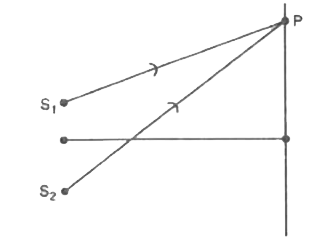In Young's double slit experiment, an interference pattern is obtained on a screen by a light of wavelength 6000 ∘A coming from the coherent sources S1andS2. At certain point P on the screen third dark fringe is formed. Then, the path difference S1P–S2P in micron isSolution in Telugu
0.75
1.5
3
4.5
The correct Answer is:b
Path difference for dark fringe,
Δx=(2n+1)λ2
∴δx=1.5 micron
Topper's Solved these Questions
Similar Questions
A tanserve wave is repsemted by the equation y=2sin(30t−40x) and the measerments of distances are in meters, then the velocity of propagation is
View SolutionA man of weight 50 kg carries an object to a height of 20m in a time of 10 sec. The power used by the man in this process is 2000W, then find the weight of the object carried by the man [assume g=10ms−2]
View SolutionLet S1 and S2 be the two slits in Young's double-slit experiment. If central maxima is observed at P and angle ∠S1PS2=θ, then fringe width for the light of wavelength λ will be
View SolutionIn Young's double slit experiment, an interference pattern is obtained on a screen by a light of wavelength 6000Å, coming from the coherent sources S1 and S2. At certain point P on the screen third dark fringe is formed. Then the path difference S1P−S2P in microns is
View SolutionAt two point P and Q on screen in Young's double slit experiment, waves from slits S1 and S2 have a path difference of 0 and λ4 respectively. The ratio of intensities at P and Q will be:
View SolutionThree coherent sources S_(1), S_(2)" and" S_(3) can throw light on a screen. With S_(1) switched on intensity at a point P on the screen was observed to be I. With only S_(2) on, intensity at P was 2I and when all three are switched on the intensity at P becomes zero. Intensity at P is I when S_(1)" and" S_(2) are kept on. Find the phase difference between the waves reaching at P from sources S_(1) "and" S_(3) .
View SolutionIn the case of light waves from two coherent sources S_(1) and S_(2) , there will be constructive interference at an arbitrary point P, the path difference S_(1)P - S_(2)P is
View SolutionIn an interference pattern the path difference between waves starting from S1 and S2 and reaching at P is 1.5 microns i.e. S2P−S1P=1.5 microns. If the wavelength of light used be 6000Å, then the point P is :

View SolutionAt two points P and Q on a screen in Young's double slit experiment, waves from slits S_(1) and S_(2) have a path difference of 0 and (lambda)/(4) respectively. The ratio of intensities at P and Q will be
View SolutionTwo coherent point sources S1 and S2 are separated by a small distance 'd' as shown. The fringes obtained on the screen will be :
View SolutionIn a modified set up of Young's double slit experiment, it is given that SS2−SS1=λ4 i.e., the source S is not equidistant from the slits S1andS2.
(a) Obtain the condition for constructive and destructive interference at any point P on the screen in terms of the path difference Δ=S2P−S1P.
(b) Does the observed central bright fringe lie above or below O ? Give reason in support of your answer.
View SolutionAt two points P and Q on a screen in Young's double slit experiment, waves from slits S1andS2 have a path difference of O and λ4 respectively. The ratio of intensities at P and Q will be ......
View SolutionIn the case of light waves from two coherent sources S1 and S2, there will be constructive interference at an arbitrary point P, the path difference S1P−S2P is
View SolutionIn Young’s double-slit experiment, an interference pattern is obtained on a screen by a light of wavelength 6000overset@A , coming from the coherent sources S_1 and S_2 .At certain point P on the screen, third dark fringe is formed. Then the path difference S_1P-S_2P in microns is
View SolutionIn Young's double slit experiment, an interference pattern is obtained on a screen by a light of wavelength 6000Å, coming from the coherent sources S1 and S2. At certain point P on the screen third dark fringe is formed. Then the path difference S1P−S2P in microns is
View Solution
